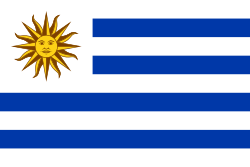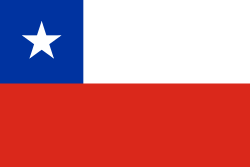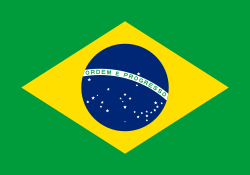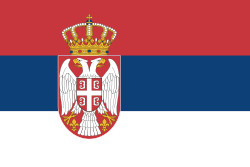Rio Open 2018 – mužská dvouhra
| Rio Open 2018 | ||||
|---|---|---|---|---|
| Vítěz | ||||
| Finalista | ||||
| Výsledek | 6–2, 6–3 | |||
| Soutěže | ||||
| mužská dvouhra • mužská čtyřhra | ||||
| ||||
Mužská dvouhra Rio Open 2018 probíhala ve druhé polovině února 2018. Do singlové soutěže riodejaneirského tenisového turnaje nastoupilo třicet dva hráčů. Obhájcem titulu byl druhý nasazený rakouský tenista Dominic Thiem, kterého ve čtvrtfinále vyřadil Verdasco.
Vítězem se stal 25letý osmý nasazený Diego Schwartzman, jenž ve finále zdolal španělskou turnajovou šestku Fernanda Verdasca po dvousetovém průběhu 6–2 a 6–3. V probíhající sezóně si tak připsal premiérové turnajové vítězství, které představovalo po trofeji z Istanbul Open 2016 druhý singlový titul na okruhu ATP Tour a první v kategorii ATP 500. V následném vydání žebříčku ATP z 26. února 2018 se poprvé v kariéře posunul do elitní světové dvacítky, když mu patřila 18. příčka.[1]
Nasazení hráčů
Čtyři nejvýše nasazení hráči obdrželi volný los do druhého kola.
 Marin Čilić (2. kolo)
Marin Čilić (2. kolo) Dominic Thiem (čtvrtfinále)
Dominic Thiem (čtvrtfinále) Pablo Carreño Busta (2. kolo)
Pablo Carreño Busta (2. kolo) Albert Ramos-Viñolas (2. kolo)
Albert Ramos-Viñolas (2. kolo) Fabio Fognini (semifinále)
Fabio Fognini (semifinále) Diego Schwartzman (vítěz)
Diego Schwartzman (vítěz) Pablo Cuevas (čtvrtfinále)
Pablo Cuevas (čtvrtfinále) Fernando Verdasco (finále)
Fernando Verdasco (finále)
Pavouk
| Legenda | ||
|
|
|
Finálová fáze
| Semifinále | Finále | |||||||||||
| 6 | | 7 | 6 | |||||||||
| | 5 | 2 | ||||||||||
| 6 | | 6 | 6 | |||||||||
| 8 | | 2 | 3 | |||||||||
| 5 | | 1 | 5 | |||||||||
| 8 | | 6 | 7 | |||||||||
Horní polovina
| První kolo | Druhé kolo | Čtvrtfinále | Semifinále | ||||||||||||||||||||||
| 1 | | 6 | 6 | ||||||||||||||||||||||
| Q | | 3 | 2 | 1 | | 3 | 68 | ||||||||||||||||||
| | 7 | 3 | 7 | | 6 | 710 | |||||||||||||||||||
| | 5 | 6 | 5 | | 3 | 4 | |||||||||||||||||||
| | 2 | 2r | 6 | | 6 | 6 | |||||||||||||||||||
| | 6 | 3 | | 2 | 3 | ||||||||||||||||||||
| WC | | 1r | 6 | | 6 | 6 | |||||||||||||||||||
| 6 | | 4 | 6 | | 7 | 6 | |||||||||||||||||||
| 4 | | 6 | 3 | 6 | | 5 | 2 | ||||||||||||||||||
| | 3 | 6 | 4 | 4 | | 5 | 3 | ||||||||||||||||||
| | 3 | 63 | | 7 | 6 | ||||||||||||||||||||
| | 6 | 77 | | 7 | 6 | ||||||||||||||||||||
| LL | | 6 | 5 | 7 | 7 | | 5 | 3 | |||||||||||||||||
| | 4 | 7 | 5 | LL | | 5 | 1 | ||||||||||||||||||
| WC | | 77 | 610 | 3 | 7 | | 7 | 6 | |||||||||||||||||
| 7 | | 65 | 712 | 6 | |||||||||||||||||||||
Dolní polovina
| První kolo | Druhé kolo | Čtvrtfinále | Semifinále | ||||||||||||||||||||||
| 5 | | 65 | 7 | 6 | |||||||||||||||||||||
| WC | | 77 | 5 | 2 | 5 | | 4 | 6 | 78 | ||||||||||||||||
| Q | | 6 | 1 | 3r | | 6 | 4 | 66 | |||||||||||||||||
| | 4 | 6 | 4 | 5 | | 63 | 6 | 6 | |||||||||||||||||
| | 7 | 6 | | 77 | 3 | 1 | |||||||||||||||||||
| PR | | 5 | 0 | | 6 | 5 | 6 | ||||||||||||||||||
| Q | | 4 | 1 | 3 | | 2 | 7 | 2 | |||||||||||||||||
| 3 | | 6 | 6 | 5 | | 1 | 5 | ||||||||||||||||||
| 8 | | 6 | 3 | 6 | 8 | | 6 | 7 | |||||||||||||||||
| | 2 | 6 | 3 | 8 | | 63 | 6 | 6 | |||||||||||||||||
| | 3 | 3 | | 77 | 2 | 0 | |||||||||||||||||||
| | 6 | 6 | 8 | | 6 | 6 | |||||||||||||||||||
| PR | | 7 | 6 | 2 | | 4 | 0 | ||||||||||||||||||
| | 5 | 2 | PR | | 2r | ||||||||||||||||||||
| | 2 | 5 | 2 | | 4 | ||||||||||||||||||||
| 2 | | 6 | 7 | ||||||||||||||||||||||
Odkazy
Reference
V tomto článku byl použit překlad textu z článku 2018 Rio Open – Singles na anglické Wikipedii.
- ↑ Petr Pokorný, Ondřej Jirásek, Luboš Zabloudil, TenisPortal.cz. Schwartzman v Riu získal první trofej z turnaje ATP 500 [online]. TenisPortal.cz, 2018-02-27 [cit. 2018-03-03]. Dostupné online.
Externí odkazy
- Rio Open 2018 – mužská dvouhra [PDF]. ATP Tour, Inc. [cit. 2018-03-03]. Dostupné online. (anglicky)
- Rio Open 2018 – kvalifikace mužské dvouhry [PDF]. ATP Tour, Inc. [cit. 2018-03-03]. Dostupné online. (anglicky)
Média použitá na této stránce
Při zobrazení tohoto souboru lze snadno přidat orámování
Vlajka České republiky. Podoba státní vlajky České republiky je definována zákonem České národní rady č. 3/1993 Sb., o státních symbolech České republiky, přijatým 17. prosince 1992 a který nabyl účinnosti 1. ledna 1993, kdy rozdělením České a Slovenské Federativní republiky vznikla samostatná Česká republika. Vlajka je popsána v § 4 takto: „Státní vlajka České republiky se skládá z horního pruhu bílého a dolního pruhu červeného, mezi něž je vsunut žerďový modrý klín do poloviny délky vlajky. Poměr šířky k její délce je 2 : 3.“
Flag of Portugal, created by Columbano Bordalo Pinheiro (1857-1929), officially adopted by Portuguese government in June 30th 1911 (in use since about November 1910).
The flag of the Dominican Republic has a centered white cross that extends to the edges. This emblem is similar to the flag design and shows a bible, a cross of gold and 6 Dominican flags. There are branches of olive and palm around the shield and above on the ribbon is the motto "Dios,Patria!, Libertad" ("God, Country, Freedom") and to amiable freedom. The blue is said to stand for liberty, red for the fire and blood of the independence struggle and the white cross symbolized that God has not forgotten his people. "Republica Dominicana". The Dominican flag was designed by Juan Pablo Duarte, father of the national Independence of Dominican Republic. The first dominican flag was sewn by a young lady named Concepción Bona, who lived across the street of El Baluarte, monument where the patriots gathered to fight for the independence, the night of February 27th, 1844. Concepción Bona was helped by her first cousin María de Jesús Pina.
The flag of the Dominican Republic has a centered white cross that extends to the edges. This emblem is similar to the flag design and shows a bible, a cross of gold and 6 Dominican flags. There are branches of olive and palm around the shield and above on the ribbon is the motto "Dios,Patria!, Libertad" ("God, Country, Freedom") and to amiable freedom. The blue is said to stand for liberty, red for the fire and blood of the independence struggle and the white cross symbolized that God has not forgotten his people. "Republica Dominicana". The Dominican flag was designed by Juan Pablo Duarte, father of the national Independence of Dominican Republic. The first dominican flag was sewn by a young lady named Concepción Bona, who lived across the street of El Baluarte, monument where the patriots gathered to fight for the independence, the night of February 27th, 1844. Concepción Bona was helped by her first cousin María de Jesús Pina.















